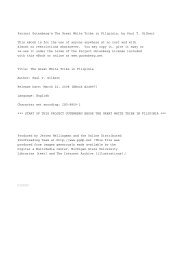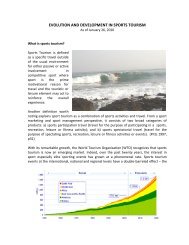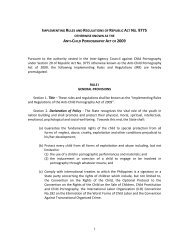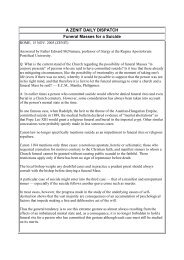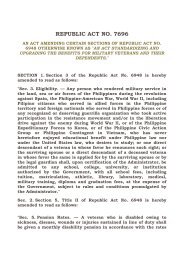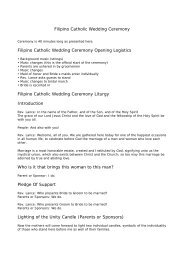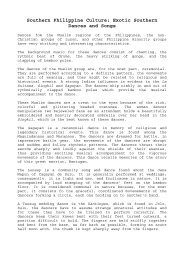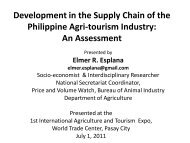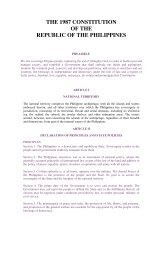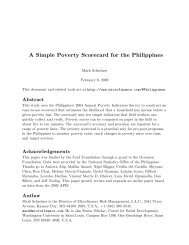The Eskaya Script - About the Philippines
The Eskaya Script - About the Philippines
The Eskaya Script - About the Philippines
You also want an ePaper? Increase the reach of your titles
YUMPU automatically turns print PDFs into web optimized ePapers that Google loves.
<strong>The</strong> <strong>Eskaya</strong> <strong>Script</strong><br />
by Hector Santos<br />
© 1996 by Hector Santos<br />
All rights reserved.<br />
<strong>The</strong> <strong>Eskaya</strong> of Bohol is an interesting group of people who claim to have direct<br />
connections to ancient kingdoms in Butuan, <strong>the</strong> island of Sumatra, and <strong>the</strong><br />
Middle East. Although <strong>the</strong>y appear to have very little cultural and physical<br />
differences with <strong>the</strong>ir neighbors, <strong>the</strong>y still claim to be different. Inasmuch as<br />
<strong>the</strong>re is a dearth of reliable information pertaining to this group I will summarize<br />
what is known about <strong>the</strong>m— data that has come from only one man and which<br />
has not been verified against any o<strong>the</strong>r source for <strong>the</strong> simple reason that I have<br />
not found o<strong>the</strong>r sources.<br />
Our source of information is Jes B. Tirol, who is affiliated with <strong>the</strong> University of<br />
Bohol in Tagbilaran, Bohol. Tirol had been able to get information because his<br />
fa<strong>the</strong>r, Victoriano Tirol, Sr., was a trusted lawyer of one of <strong>the</strong> late leaders of <strong>the</strong><br />
<strong>Eskaya</strong> society. In spite of his access to informants, Tirol acknowledges that<br />
some information is only made available via oral tradition to a few chosen<br />
people within <strong>the</strong> group. What we will be dealing with is "public" or open<br />
information that, while not necessarily secret, is not widely disseminated ei<strong>the</strong>r.<br />
<strong>Eskaya</strong> Books<br />
What <strong>the</strong> <strong>Eskaya</strong> consider to be an official record of <strong>the</strong>ir civilization is<br />
contained in a few books (notebooks) which include Unang Katawhan sa Bohol<br />
(First People of Bohol) also known as Pinay, Rangman (encyclopedia), Simplet<br />
(dictionary), Abadeha (Origin of <strong>the</strong> Alphabet), Cuadra (Mechanics of <strong>the</strong><br />
Alphabet), Atekesis (Botanical Knowledge), Daylinda (Romantic story of one<br />
chief), and Aritmetica (Arithmetic). <strong>The</strong> books are not dated so <strong>the</strong>y could be<br />
anywhere from a few decades to a few centuries old. <strong>The</strong> <strong>Eskaya</strong> claim an<br />
ancient date for <strong>the</strong> books but <strong>the</strong> publishing date has not been verified. Suffice<br />
to say, everything we discuss has <strong>the</strong> attribute of “deniability.”<br />
In view of <strong>the</strong> tremendous amount of fantastic information that can be gleaned<br />
from <strong>the</strong>se <strong>Eskaya</strong> “books,” we have to limit ourselves mostly to <strong>the</strong> subject of<br />
<strong>the</strong> <strong>Eskaya</strong> script and <strong>the</strong>ir number system so we can have a mangeable topic.<br />
We will also discuss briefly how <strong>the</strong> <strong>Eskaya</strong> purportedly got into Bohol.
<strong>Eskaya</strong> roots<br />
<strong>The</strong> first <strong>Eskaya</strong> to settle in Bohol was a certain soldier-king named Dangko. He<br />
was originally from Sumatra-Manselis. Dangko, his followers and his twelve<br />
children (eleven boys and one girl) left Sumatra for unknown reasons. <strong>The</strong>y first<br />
settled in Hindangan, Lanao which is now Sindangan Bay, Zamboanga.<br />
Eventually, <strong>the</strong>y moved on to Tambo, Talibon in Bohol. Succeeding generations<br />
settled o<strong>the</strong>r parts of Bohol.<br />
<strong>The</strong> only daughter of Dangko married a chieftain of Butuan and spread <strong>Eskaya</strong><br />
influence in that region according to <strong>the</strong>ir accounts.<br />
No dates are given for any of <strong>the</strong>se important <strong>Eskaya</strong> milestones. Whenever<br />
dates are mentioned, it is not clear what calendrical system <strong>the</strong>y are referring to<br />
because <strong>the</strong> dates are inconsistent with any o<strong>the</strong>r calendar that we know of. <strong>The</strong>y<br />
are also inconsistent relative to o<strong>the</strong>r dated events in <strong>the</strong>ir accounts. For instance,<br />
Jesus Christ was supposed to have been born in 677 and <strong>the</strong> reign of Sikatuna<br />
was supposed to have began in 1272. <strong>The</strong>se dates are obviously inconsistent<br />
with everything we know about Sikatuna and Jesus Christ.<br />
Writing system<br />
<strong>The</strong> <strong>Eskaya</strong> writing system was devised by one man named Pinay. Again, <strong>the</strong>re<br />
are no dates available for when this invention was developed. We reproduce on<br />
ano<strong>the</strong>r page a chart showing a subset of <strong>the</strong> complete list of characters/symbols<br />
which is reported to number close to one thousand. This is what <strong>the</strong>y look like:<br />
What is obvious is that many symbols represent sounds which do not exist in<br />
Philippine languages or even most Austronesian languages. Consonant clusters<br />
within syllables are especially interesting as <strong>the</strong>y are not natural sounds in any of<br />
<strong>the</strong> languages spoken in <strong>the</strong> region. Of course, this is what <strong>the</strong> <strong>Eskaya</strong> claim—
<strong>the</strong>ir language is totally unrelated to o<strong>the</strong>r Philippine languages. However, we<br />
know that all languages (except Basque?) are related to and have cognates with<br />
o<strong>the</strong>rs in <strong>the</strong>ir family. Someday, somebody might be able to say for sure whe<strong>the</strong>r<br />
<strong>Eskaya</strong> is really a unique language or if, like <strong>the</strong>ir script, was invented by one<br />
man.<br />
I will now try to make a few general comments on <strong>the</strong> structure of <strong>the</strong> <strong>Eskaya</strong><br />
script. This is, of course, <strong>the</strong> view of an outsider who was never taught <strong>the</strong> script.<br />
This is <strong>the</strong> best that I can do and will have to suffice until <strong>the</strong> time comes when<br />
somebody who was initiated into <strong>the</strong> secrets of <strong>the</strong> script decides to write about<br />
it.<br />
<strong>The</strong> basic structure of <strong>the</strong> script is that of a syllabary. Like Indic scripts, basic<br />
value of certain symbols are modified by ligatures, although only to add a final<br />
consonant. <strong>The</strong>re are symbols for V, CV, CVC, CCV, CCVC, VC, VCC, CVCC,<br />
CCVCC (C=consonant, V=vowel), and diphthongs. This is why <strong>the</strong>re are so<br />
many different symbols in <strong>the</strong> <strong>Eskaya</strong> scrirpt (estimated to be around one<br />
thousand). However, if composite symbols are not counted, <strong>the</strong> number will be a<br />
lot less.<br />
If you examine <strong>the</strong> <strong>Eskaya</strong> symbol chart on ano<strong>the</strong>r page, you will notice that <strong>the</strong><br />
shapes for ba, bi, and be are completely unrelated. <strong>The</strong> same can be said for ba,<br />
bla, and bra. This would show that <strong>Eskaya</strong> is a “pure” syllabary much like<br />
Japanese Katakana. Going to <strong>the</strong> subchart on <strong>the</strong> lower right-hand corner note<br />
that in sa, sa’, sab, sak, sad, sag, sal, sam, san, sao, sap, sar, sas, sat, say, and<br />
sang, (not all shown) <strong>the</strong> basic CV symbol sa is modified into <strong>the</strong> o<strong>the</strong>r values<br />
by <strong>the</strong> addition of a ligature. <strong>The</strong> ligature defines <strong>the</strong> value of <strong>the</strong> final consonant<br />
in <strong>the</strong> resulting CVC syllable.<br />
But that is not all. <strong>The</strong> script is also reported to have <strong>the</strong> characteristics of<br />
logograms, with some symbols doubling as representations for words and ideas<br />
at <strong>the</strong> same time <strong>the</strong>y represent sounds. This characteristic is similar to a<br />
characteristic of Chinese, Egyptian, and Mayan writing systems.<br />
According to Tirol, <strong>the</strong> <strong>Eskaya</strong> symbols represent different positions of Man’s<br />
head, body, arms, and legs. He adds, “<strong>The</strong> symbols were derived from ‘As<br />
Pormos Minimi’ which is translated in Bisayan as ‘gikan sa lawas sa tawo<br />
(taken from <strong>the</strong> body of man).’ Upon closer analysis, ‘As Pormos Minimi’ is<br />
actually a corruption of <strong>the</strong> Latin phrase ‘ad formus hominem (from <strong>the</strong> body of<br />
men)’.”<br />
Number system<br />
<strong>The</strong>re is nothing extraordinary about <strong>the</strong> <strong>Eskaya</strong> number system. It is <strong>the</strong> same<br />
decimal system that we use. What is unusual is that <strong>the</strong>y have symbols for <strong>the</strong><br />
numbers, something missing from <strong>the</strong> classic Philippine scripts. <strong>The</strong>y have a<br />
symbol but not a name for zero (0) and use a positional system for notation.
<strong>The</strong>ir names for <strong>the</strong> numbers (0=no name, 1=oy, 2=tre, 3=koy, 4=pan, 5=sing,<br />
6=nom, 7=pin, 8=wal, 9=sem and 10=pon), except for wal and pon, are not close<br />
to <strong>the</strong> names used in o<strong>the</strong>r Philippine languages. <strong>The</strong>y have unique names<br />
corresponding to twenty (kaw), thirty (krat), hundred (ten), and thousand (man).<br />
<strong>The</strong>ir names for <strong>the</strong> o<strong>the</strong>r numbers are formed from a combination of <strong>the</strong>se<br />
uniqque names so that eleven is pon oy (ten=pon plus one=oy) and twenty-two is<br />
kaw tre (twenty=kaw plus two=tre).<br />
Symbols for <strong>the</strong> numerals are also shown in <strong>the</strong> chart on <strong>the</strong> separate page. <strong>The</strong>ir<br />
shapes make it easy to believe that <strong>the</strong> <strong>Eskaya</strong> script was invented by one man.<br />
<strong>The</strong> <strong>Eskaya</strong> have names for four ma<strong>the</strong>matical operation but <strong>the</strong>ir symbols for<br />
<strong>the</strong> operations are suspiciously out of character when you consider <strong>the</strong>ir o<strong>the</strong>r<br />
written symbols:<br />
addition = as<br />
subtraction T ton<br />
multiplication % bret<br />
division / pen<br />
<strong>The</strong> symbol for subtraction cannot be shown as type here; it looks like an<br />
upsilon, or a cross between a "T"and a "Y." Note that <strong>the</strong>ir name for division<br />
(pen) is close enough to <strong>the</strong>ir name for seven (pin) to cause confusion.<br />
Calendar system<br />
Whereas <strong>the</strong> names for <strong>the</strong> numbers are very different in <strong>Eskaya</strong> from o<strong>the</strong>r<br />
languages, <strong>the</strong>ir names for <strong>the</strong> days of <strong>the</strong> week and <strong>the</strong> months are not very<br />
different from Spanish names. Why is this so?<br />
Days of <strong>the</strong> week:<br />
Leni Lunes Monday<br />
Mimati Martes Tuesday<br />
Mibol Miercoles Wednesday<br />
Hubir Jueves Thursday<br />
? Viernes Friday<br />
Sanubi Sabado Saturday<br />
Llongo Domingo Sunday<br />
? not shown by Tirol
Months:<br />
E-mi-o Enero January<br />
Hebi-o Febrero February<br />
Maso Marso March<br />
Kabir Abril April<br />
Ma-o Mayo May<br />
Hubi Junio June<br />
Hubi-on Julio July<br />
Tatubi Agosto August<br />
Sitibi Septiembre September<br />
Oktubi Octobre October<br />
Nobi Noviembre November<br />
Dibi Diciembre December<br />
<strong>Eskaya</strong> society in hiatus?<br />
According to Tirol, <strong>the</strong> <strong>Eskaya</strong>s do not have a system for electing leaders. <strong>The</strong>y<br />
wait for someone to rise and say that he has received a mandate from God and<br />
will lead <strong>the</strong>m. <strong>The</strong>y call this recurring messiah “Ay Sono.” He may be a<br />
soldier-king or a prophet-teacher, and <strong>the</strong> <strong>Eskaya</strong>s have had both kinds of<br />
leaders off-and-on throught <strong>the</strong>ir history.<br />
At this time <strong>the</strong>y are without a leader. <strong>The</strong>ir last leader was Mariano Datahan,<br />
who died at <strong>the</strong> age of 107 on January 6, 1949.<br />
Additional Reading<br />
1. Santos, Hector. "Butuan silver strip deciphered?" in Sulat sa Tansô, 2:5<br />
(June 1995), 6-7.<br />
2. Tirol, Jes B. "Bohol: a new Jerusalem?" in <strong>The</strong> Bohol Chronicle XXXV:<br />
44 (1988), 1 ff.<br />
3. -----. "Bohol: a new Jerusalem?" (Last Installment) in <strong>The</strong> Bohol<br />
Chronicle XXXV: 46 (1988), 7 ff.<br />
4. -----. "Butuan paleograph deciphered using eskaya script," in UB Update<br />
1:4 (1990): 6 ff. (Note: A University of Bohol publication.)<br />
5. -----. "ESKAYA OF BOHOL: Its Revered Leaders" in <strong>The</strong> Bohol<br />
Chronicle XL: 8 (June 22, 1993), 3 ff.<br />
6. -----. "ESKAYA OF BOHOL: Its System of Writing" in <strong>The</strong> Bohol<br />
Chronicle XL: 9 (July 4, 1993), 3 ff.<br />
7. -----. "ESKAYA OF BOHOL: Origin of Its System of Writing" in <strong>The</strong><br />
Bohol Chronicle XL: 10 (July 11, 1993), 3 ff.<br />
8. -----. "ESKAYA OF BOHOL: Its Numerals and Symbols" in <strong>The</strong> Bohol
Chronicle XL: 11 (July 18, 1993), 4 ff.<br />
9. -----. "ESKAYA OF BOHOL: Its Abstruse Literature" in <strong>The</strong> Bohol<br />
Chronicle XL: 12 (July 25, 1993), 3 ff.<br />
10. -----. "ESKAYA OF BOHOL: Instilling Discipline" in <strong>The</strong> Bohol<br />
Chronicle XL: 13 (August 1, 1993), 3 ff.<br />
O<strong>the</strong>r Mysterious Philippine <strong>Script</strong>s<br />
• <strong>The</strong> Calatagan Pot, a clay pot with writing around its neck.<br />
• Errors in Early Calatagan Pot Material, be careful when reading early<br />
material.<br />
• Calatagan Pot Translations, early attempts to decipher <strong>the</strong> script.<br />
• <strong>The</strong> Butuan Silver Strip, a silver bar with writing inscribed by a knife.<br />
• Butuan Silver Strip Deciphered?, an attempt to decipher <strong>the</strong> writing using<br />
<strong>the</strong> <strong>Eskaya</strong> script.<br />
• <strong>The</strong> Butuan Ivory Seal, a seal for making an impression on wax.<br />
• Back to Mystery <strong>Script</strong>s of <strong>the</strong> <strong>Philippines</strong>, your opening page to <strong>the</strong><br />
mystery scripts.<br />
• Back to A Philippine Leaf, your introductory page to ancient<br />
<strong>Philippines</strong>.<br />
To cite:<br />
Santos, Hector. "<strong>The</strong> <strong>Eskaya</strong> <strong>Script</strong>" in A Philippine Leaf at<br />
http://www.bibingka.com/dahon/mystery/eskaya.htm. US, January 25, 1997.



